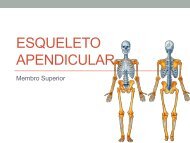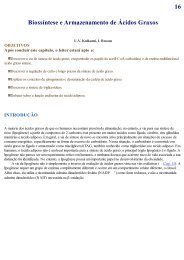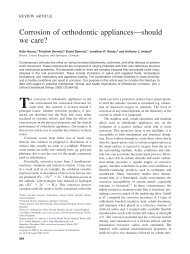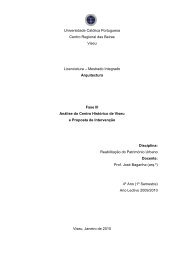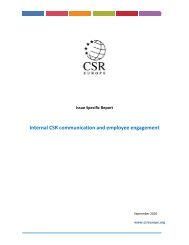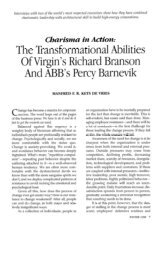Ethics in HCI - Molar
Ethics in HCI - Molar
Ethics in HCI - Molar
- TAGS
- ethics
- molar
- molar.crb.ucp.pt
Create successful ePaper yourself
Turn your PDF publications into a flip-book with our unique Google optimized e-Paper software.
ABSTRACT<br />
Users are human. As <strong>HCI</strong> professionals we must be sure<br />
that our fellow humans perceive their encounter with<br />
usability and design professionals as pleasant without<br />
sacrific<strong>in</strong>g the accuracy of our results. There are guidel<strong>in</strong>es<br />
produced by professional organizations like the APA and<br />
the ACM about how <strong>HCI</strong> professionals should behave.<br />
However, there are few examples from real life about how<br />
to translate this <strong>in</strong>formation <strong>in</strong>to everyday behavior. This<br />
panel will discuss specific examples of <strong>HCI</strong> dilemmas that<br />
the panelists have faced <strong>in</strong> their daily work.<br />
Keywords<br />
<strong>Ethics</strong>, <strong>HCI</strong> professional issues, social comput<strong>in</strong>g.<br />
PANELISTS<br />
Brenda Laurel<br />
Art Center College of Design<br />
Email: blaurel@tauzero.com<br />
Carolyn Snyder<br />
Snyder Consult<strong>in</strong>g<br />
88 Brookwood Drive<br />
Salem, NH 03079, USA<br />
Email: snyder3961@mediaone.net<br />
Whitney Quesenbery<br />
Cognetics Corporation<br />
51 Everett Drive #103B<br />
PO Box 386<br />
Pr<strong>in</strong>ceton Junction, NJ 08829, USA<br />
Email: whitneyq@cognetics.com<br />
Chauncey E. Wilson<br />
Bentley College<br />
Email: chaunsee@aol.com<br />
Rolf Molich<br />
DialogDesign<br />
Skovkrogen 3<br />
DK-3660 Stenlose, Denmark<br />
Email: molich@dialogdesign.dk<br />
PANEL ORGANIZER<br />
Rolf Molich<br />
Contact <strong>in</strong>formation above.<br />
CHI2001 Panel Documentation<br />
<strong>Ethics</strong> <strong>in</strong> <strong>HCI</strong><br />
BACKGROUND<br />
Ethical issues permeate our profession, but there are<br />
relatively few public discussions of these issues, perhaps<br />
because they are uncomfortable for many practitioners. A<br />
quick survey of the ACM Digital library on topics<br />
show<strong>in</strong>g the key word ethics produced 69 hits with only<br />
about 3 articles focus<strong>in</strong>g on the concerns of <strong>HCI</strong><br />
practitioners.<br />
Informed consent and User Self-Esteem<br />
Consider a simple example, the use of videotape <strong>in</strong><br />
usability and field studies. Wendy Mackay, <strong>in</strong> one of the<br />
few papers specific to the <strong>HCI</strong> community [4], wrote of<br />
how easy it is to compromise our <strong>in</strong>tegrity when we<br />
employ video (or audio) to present our results and<br />
<strong>in</strong>fluence others. For example, a question that Mackay asks<br />
is “do we need to have <strong>in</strong>ternal participants who have<br />
already signed an employee agreement about be<strong>in</strong>g<br />
videotaped also sign a consent form?” Many <strong>HCI</strong><br />
colleagues forego the consent form for <strong>in</strong>ternal participants,<br />
but this is probably an ethical violation s<strong>in</strong>ce a video of an<br />
<strong>in</strong>ternal person do<strong>in</strong>g poorly on a task could affect his/her<br />
reputation at work.<br />
Our belief is that <strong>in</strong>ternal participants should be afforded<br />
equal (or perhaps greater) protection than external<br />
participants, even to the extent of promis<strong>in</strong>g that their tape<br />
will not be shown to anyone other than the <strong>HCI</strong> team. A<br />
key ethical tenet is that the participant should leave a test<br />
feel<strong>in</strong>g no worse than when they arrived and ideally should<br />
feel better because they learned someth<strong>in</strong>g, or contributed<br />
to a better design.<br />
Anonymity<br />
Field studies often present <strong>HCI</strong> colleagues with ethical<br />
dilemmas. For example, a <strong>HCI</strong> colleague can sometimes<br />
f<strong>in</strong>d it difficult to preserve anonymity (and confidentiality)<br />
while at the same time provid<strong>in</strong>g feedback to customers on<br />
the results of field studies. Customers often want to hear<br />
about the results of field studies and some may even<br />
demand to know as a condition for allow<strong>in</strong>g <strong>in</strong>terviews.<br />
How do you respond to a senior vice president who asks<br />
you “How did Fred do with the new product?” If your<br />
visit focuses on only a few users and you promised a<br />
report on your visit, how do you <strong>in</strong>sure that the<br />
anonymity of the feedback is not compromised?<br />
CHI2001 Panel Proposal Page 1 <strong>Ethics</strong> <strong>in</strong> <strong>HCI</strong>
There are several methods to <strong>in</strong>sure anonymity: put <strong>in</strong><br />
writ<strong>in</strong>g the conditions of the visit and make sure that this is<br />
a prom<strong>in</strong>ent topic <strong>in</strong> preparations and plann<strong>in</strong>g. You can<br />
also say that there will be an aggregate report from several<br />
different customers, but that no <strong>in</strong>dividuals will be<br />
identified.<br />
Data Integrity and Presentation<br />
The manner <strong>in</strong> which we report the results of product<br />
evaluations presents some <strong>in</strong>terest<strong>in</strong>g ethical issues for<br />
<strong>HCI</strong> practitioners. S<strong>in</strong>ce we have to work with product<br />
teams, there may be a tendency to soft pedal bad results to<br />
preserve a work<strong>in</strong>g relationship with that team. The ability<br />
to simultaneously present bad results and keep good<br />
relationships is a difficult skill to learn but is important if<br />
we are to fulfill the user advocate role. Mackay [4]<br />
discusses how highlight tapes can be “doctored” by<br />
omitt<strong>in</strong>g particular segments or by mak<strong>in</strong>g “rare events<br />
appear representative”.<br />
A f<strong>in</strong>al ethical issue <strong>in</strong> report<strong>in</strong>g is the validity and<br />
reliability of the data. At the 2000 UPA conference, a<br />
group of <strong>HCI</strong> practitioners discussed how few usability<br />
reports address validity and reliability, even at the most<br />
basic level. Are we be<strong>in</strong>g sloppy (and perhaps unethical) <strong>in</strong><br />
present<strong>in</strong>g usability reports that fail to address<br />
fundamental aspects of data <strong>in</strong>tegrity?<br />
Undue Persuasion<br />
The design of persuasive technologies presents some<br />
ethical issues for <strong>HCI</strong> designers. [3] highlights ethical<br />
pr<strong>in</strong>ciples for the design of persuasive technologies. Here<br />
are two examples from their list:<br />
• Rule VII: “Persuasive technologies must not mis<strong>in</strong>form<br />
<strong>in</strong> order to achieve their persuasive end.”<br />
• Rule VIII: “The creators of a persuasive technology<br />
should never seek to persuade a person or persons of<br />
someth<strong>in</strong>g they themselves would not consent to be<br />
persuaded to do.”<br />
As <strong>HCI</strong> colleagues, what do we do when confronted with<br />
knowledge that a product may mis<strong>in</strong>form potential users or<br />
persuade them to do someth<strong>in</strong>g outrageous? Do we rem<strong>in</strong>d<br />
our managers of these ethical issues, quit the company, or<br />
write an expose that may land us <strong>in</strong> court?<br />
Life and Death<br />
Ethical issues can become complex when people are<br />
work<strong>in</strong>g on systems that might have life or death<br />
consequences. For example, designers of medical hardware<br />
and software make decisions that may compromise the<br />
health of an <strong>in</strong>dividual. Is it ethical to follow the advice that<br />
5-8 users will reveal the major problems of a product?<br />
Test<strong>in</strong>g 5-8 users is much cheaper than test<strong>in</strong>g large<br />
numbers so there is a trade-off of time-to-market with<br />
possibility of death because a subtle problem did not come<br />
out <strong>in</strong> the limited test<strong>in</strong>g.<br />
Push<strong>in</strong>g Back on Management<br />
Push<strong>in</strong>g back on management when there are ethical issues<br />
(especially the less obvious ones) is hard for experienced<br />
practitioners and almost impossible for the brand-new<br />
person <strong>in</strong> the field. We view this panel as the start<strong>in</strong>g po<strong>in</strong>t<br />
for a vigorous and cont<strong>in</strong>u<strong>in</strong>g discussion about how we can<br />
keep high levels of <strong>in</strong>tegrity while work<strong>in</strong>g <strong>in</strong> product<br />
development environments that can bend ethical<br />
boundaries.<br />
INTRODUCTION TO PANEL<br />
There are plenty of guidel<strong>in</strong>es for proper conduct around<br />
[1,2]. Some of the popular Human Factors textbooks<br />
conta<strong>in</strong> sections on ethics <strong>in</strong> <strong>HCI</strong>, for example [5].<br />
However, it appears that these guidel<strong>in</strong>es are relatively<br />
unknown. We offer the follow<strong>in</strong>g possible reasons for this:<br />
• The guidel<strong>in</strong>es are written <strong>in</strong> a language that is hard to<br />
understand.<br />
• The guidel<strong>in</strong>es are difficult to locate.<br />
• There are few (if any) examples of how these pr<strong>in</strong>ciples<br />
are applied <strong>in</strong> practice.<br />
• Some of the guidel<strong>in</strong>es mostly deal with usability<br />
test<strong>in</strong>g and handl<strong>in</strong>g of videotapes. These, of course, are<br />
important details, but ethical dilemmas extend far<br />
beyond usability lab practices <strong>in</strong>to all phases of<br />
product design.<br />
We don’t th<strong>in</strong>k <strong>HCI</strong> needs another code of ethics. What we<br />
do need <strong>in</strong>stead is a collection of case studies illustrat<strong>in</strong>g<br />
the ethical concerns other <strong>HCI</strong> professionals have been<br />
struggl<strong>in</strong>g with. <strong>Ethics</strong> should be a part of any formal<br />
tra<strong>in</strong><strong>in</strong>g – graduate classes, sem<strong>in</strong>ars by professionals, etc.<br />
<strong>HCI</strong> professionals face ethical issues every day. Here are<br />
some examples that could form the basis for a set of case<br />
studies.<br />
First a few simple ones:<br />
• You go <strong>in</strong>to the field. You have told your <strong>in</strong>terviewees<br />
that their comments to you are private. A senior VP<br />
asks you “who did well <strong>in</strong> the study?” What do you<br />
say?<br />
Answer: You can’t give any answer that reveals or even<br />
narrows down the identity of an <strong>in</strong>terviewee, no matter<br />
who is ask<strong>in</strong>g - a promise is a promise.<br />
CHI2001 Panel Proposal Page 2 <strong>Ethics</strong> <strong>in</strong> <strong>HCI</strong>
• A usability test center enterta<strong>in</strong>s visitors by show<strong>in</strong>g<br />
video clips with “funny” episodes from usability tests<br />
where test participants are pick<strong>in</strong>g their noses, etc.<br />
Here are some more subtle examples:<br />
• Your usability studies show that a product is not<br />
usable. Market<strong>in</strong>g folks claim that it is really usable. Do<br />
you email the CEO and lay your job on the l<strong>in</strong>e?<br />
• You are aware that a product you are work<strong>in</strong>g on is<br />
us<strong>in</strong>g some technology that someone has patented<br />
(there are lots of GUI patents now). Do you make a<br />
st<strong>in</strong>k? Talk to your boss and ask him to talk to others?<br />
• You learn that your company wants to acquire a<br />
company for some GUI technology, but you know<br />
from read<strong>in</strong>g and review<strong>in</strong>g an evaluation copy of the<br />
product that the technology is really pretty poor and<br />
even unreliable. Do you make a st<strong>in</strong>k about this or let it<br />
pass until others discover they have wasted<br />
$10,000,000 on clunky technology that they will write<br />
off <strong>in</strong> less than a year?<br />
As <strong>HCI</strong> professionals we cannot deny responsibility for<br />
the products of our work. We cannot defer responsibility<br />
to the decision makers, the managers and bus<strong>in</strong>ess<br />
sponsors that def<strong>in</strong>e the objectives of the system. We are<br />
responsible for ensur<strong>in</strong>g that ethical issues <strong>in</strong> product<br />
development are discussed openly and not hidden away <strong>in</strong><br />
bureaucratic closets.<br />
FORMAT OF PANEL<br />
Our aim is to show the diversity of ethical problems <strong>in</strong><br />
<strong>HCI</strong> through examples that members of the audience can<br />
relate to, and to give attendees an experience they could not<br />
get by read<strong>in</strong>g articles or proceed<strong>in</strong>gs, or by surf<strong>in</strong>g the<br />
web.<br />
We will discuss real dilemmas that the panelists have faced<br />
dur<strong>in</strong>g their professional career although some details may<br />
have been changed to avoid identification of the<br />
<strong>in</strong>nocent/guilty.<br />
The panel will focus on dilemmas whose solutions are nontrivial<br />
and where substantial arguments can be presented<br />
both for and aga<strong>in</strong>st a particular action.<br />
Where appropriate, we will <strong>in</strong>volve all of the audience <strong>in</strong> a<br />
f<strong>in</strong>al “vote” where members of the audience will be able to<br />
show their personal op<strong>in</strong>ion on the dilemma by wav<strong>in</strong>g<br />
yellow or blue sheets of paper.<br />
Timetable:<br />
• Introduction to panel. The panel theme and format is<br />
briefly <strong>in</strong>troduced by the panel organizer. Panelists are<br />
briefly <strong>in</strong>troduced by the organizer us<strong>in</strong>g one slide per<br />
panelist (5 m<strong>in</strong>utes). The organizer takes a quick vote<br />
of the audience to see how many people are familiar<br />
with exist<strong>in</strong>g ethical guidel<strong>in</strong>es.<br />
• Presentation of dilemmas (5 dilemmas @ 15 m<strong>in</strong>utes).<br />
Each panelist will present one dilemma us<strong>in</strong>g one or<br />
two slides. The presentation will be followed by a brief<br />
discussion where one or two other panelists contribute<br />
their op<strong>in</strong>ion. We will then allow for comments from<br />
the audience and take a quick vote to survey the<br />
attitude of the audience.<br />
• Conclud<strong>in</strong>g remarks from the panelists (10 m<strong>in</strong>utes)<br />
Some of the panelists will have extra dilemmas ready for<br />
discussion if time permits.<br />
ETHICAL DILEMMAS<br />
Brenda Laurel<br />
Dilemma 1: Your client wants to build an <strong>in</strong>clusive onl<strong>in</strong>e<br />
community. Your research shows that strong, coherent<br />
communities <strong>in</strong>variably possess means for the group to set<br />
boundaries and exclude some people from membership. Do<br />
you argue that the client needs to provide for exclusion and<br />
boundary-sett<strong>in</strong>g <strong>in</strong> order to make its onl<strong>in</strong>e community<br />
successful?<br />
Yes: It is usually a better design decision to accommodate<br />
human characteristics than to try to change them.<br />
This particular need for boundary-sett<strong>in</strong>g by<br />
communities is so strong that ignor<strong>in</strong>g it will <strong>in</strong>sure<br />
failure.<br />
No: The desire to exclude is part of the dark side of<br />
human nature. A humanistic approach seeks to<br />
improve human character. The client can make an<br />
<strong>in</strong>clusive community so attractive that it will override<br />
exclusionary impulses.<br />
Dilemma 2: Your client asks you to determ<strong>in</strong>e through<br />
user test<strong>in</strong>g an optimal shooter <strong>in</strong>terface for an onl<strong>in</strong>e game<br />
targeted to teens and adults. In the design of your research,<br />
you have the opportunity to def<strong>in</strong>e the “optimal” <strong>in</strong>terface<br />
as productive of pleasure and excitement, or as a realistic<br />
representation of do<strong>in</strong>g violent harm to another person. Do<br />
you choose pleasure over realism?<br />
Yes: The clients wants a game, not a simulation. Everyone<br />
knows that shooter games are not the same as reality,<br />
and they should not be measured by the same<br />
standards.<br />
CHI2001 Panel Proposal Page 3 <strong>Ethics</strong> <strong>in</strong> <strong>HCI</strong>
No: The only way around the accusation that shooter<br />
games encourage violence is to be sure that they<br />
portray violent actions and their consequences<br />
realistically.<br />
Carolyn Snyder<br />
Dilemma 1: You’ve found some problems <strong>in</strong> usability<br />
test<strong>in</strong>g. While none are critical, you feel that several are<br />
important and you’d like to see them fixed before release.<br />
Because the development schedule is extremely tight, only<br />
high-priority changes are be<strong>in</strong>g made.<br />
Yes: You have a responsibility to make the product as<br />
usable as possible under a situation of serious<br />
resource constra<strong>in</strong>ts. Without bluff<strong>in</strong>g, you’ll<br />
accomplish noth<strong>in</strong>g.<br />
No: Bluff<strong>in</strong>g will damage your credibility with the team,<br />
lessen<strong>in</strong>g the chance that they’ll listen to you next<br />
time. Besides, you don’t feel quite right about it.<br />
Dilemma 2: Participants <strong>in</strong> a usability test have given<br />
written consent to have the session videotaped for <strong>in</strong>ternal<br />
company purposes. They are not explicitly told that some<br />
unknown number of people will be watch<strong>in</strong>g the live video<br />
from the observation and control rooms. Are the live<br />
observers covered by the consent form?<br />
Yes: Consent<strong>in</strong>g to be<strong>in</strong>g videotaped <strong>in</strong>cludes implicit<br />
permission to be observed live.<br />
No: The participant may trust that any uncomfortable<br />
moments captured on the tape will not be shown to<br />
others, but with live action there’s no way to prevent<br />
this. Also, people <strong>in</strong> a non-public sett<strong>in</strong>g have a right<br />
to know exactly who is watch<strong>in</strong>g them.<br />
Dilemma 3: You’re a usability consultant brought <strong>in</strong> to<br />
test a web site. The web site is be<strong>in</strong>g designed and<br />
developed by a third company. The test<strong>in</strong>g reveals some<br />
usability problems. You have some ideas for solutions that<br />
you’ve seen work <strong>in</strong> other sites. You ask your client<br />
whether she wants you to <strong>in</strong>clude your recommendations<br />
<strong>in</strong> your f<strong>in</strong>al report. She says they’ve hired the design firm<br />
to solve the problems, so you should stick to document<strong>in</strong>g<br />
the f<strong>in</strong>d<strong>in</strong>gs. Do you <strong>in</strong>clude your recommendations?<br />
Yes: The client doesn’t necessarily speak for the design<br />
firm, and you are <strong>in</strong> a position to help them do their<br />
job better. You are serv<strong>in</strong>g a higher purpose – the<br />
client’s ultimate success - by pass<strong>in</strong>g along whatever<br />
wisdom you can offer.<br />
No: You don’t want to step on any toes, either at the<br />
client or the design firm. If they’ve said no to<br />
someth<strong>in</strong>g, you shouldn’t do it, even if you can do it<br />
without charg<strong>in</strong>g them extra.<br />
Whitney Quesenbery<br />
Dilemma 1: You have set up early usability tests of a<br />
paper prototype with nurses at a medical facility. The test<br />
was difficult to schedule because nurses’ time is guarded<br />
carefully and market<strong>in</strong>g carefully guards the relationship<br />
with customers. The nurs<strong>in</strong>g managers <strong>in</strong>sist on “tak<strong>in</strong>g the<br />
test” themselves first, and then on be<strong>in</strong>g present <strong>in</strong> the<br />
room dur<strong>in</strong>g the tests with the other participants to “be<br />
sure they do it right.” You believe that the managers’<br />
presence will be <strong>in</strong>timidat<strong>in</strong>g to the nurses, alter<strong>in</strong>g the<br />
results of the test. Do you cont<strong>in</strong>ue with the usability<br />
tests?<br />
Yes: If you turn down this opportunity to work with<br />
users, it might be impossible to set up a test <strong>in</strong> the<br />
future. Although you would have to carefully<br />
evaluate the test results for bias caused by the<br />
managers, you will still get valuable comments on the<br />
concepts <strong>in</strong> the prototype.<br />
No: Putt<strong>in</strong>g the nurses <strong>in</strong>to a situation where they are<br />
be<strong>in</strong>g asked to react and comment freely <strong>in</strong> front of<br />
their obviously critical managers would be so<br />
stressful as to be unethical. You should f<strong>in</strong>d a way to<br />
avoid runn<strong>in</strong>g these tests.<br />
Dilemma 2: You are the leader of a group develop<strong>in</strong>g user<br />
<strong>in</strong>terface design standards to promote consistency and<br />
usability among your company's products. You have<br />
been work<strong>in</strong>g with this group for several months and have<br />
what you consider a solid set of standards published and<br />
accepted, despite some <strong>in</strong>itial resistance to the concept of<br />
either standardization or usability. Several products are<br />
close to release with new versions <strong>in</strong>corporat<strong>in</strong>g your<br />
standards. You are work<strong>in</strong>g with a new product group and<br />
discover a problem <strong>in</strong> the standards. You can th<strong>in</strong>k of a<br />
work-around that will enable them to stay <strong>in</strong> compliance,<br />
but realize that it would be better to modify the standard<br />
to take this new <strong>in</strong>formation <strong>in</strong>to account. The change<br />
would<br />
require substantial modification to the earlier products. It is<br />
unlikely that you will be able to make this change <strong>in</strong> the<br />
future. Do you change the standards?<br />
Yes: Like design, develop<strong>in</strong>g standards is an iterative<br />
process. The newest product to use the standards<br />
CHI2001 Panel Proposal Page 4 <strong>Ethics</strong> <strong>in</strong> <strong>HCI</strong>
exposed new <strong>in</strong>formation and flaws should be<br />
corrected to make all of the user <strong>in</strong>terfaces stronger.<br />
No: Because you have a valid work-around, practical<br />
expediencies should rule. Sometimes good ideas or<br />
critical <strong>in</strong>formation come too late.<br />
Chauncey Wilson<br />
Dilemma 1: You are a manager of a <strong>HCI</strong> group at a major<br />
software company. Your latest product is almost through<br />
the beta process and is gett<strong>in</strong>g good reviews. At the very<br />
last customer visit, a potential scalability problem is<br />
observed. Later, <strong>in</strong> discussions with a trusted technical<br />
source, you come to believe that this scalability issue<br />
(which is not related to the UI work that your team has<br />
done) could have catastrophic consequences for large (but<br />
not small or medium) customers. The next day is sign-off<br />
for the product and everyone's large bonus depends on a<br />
unanimous sign-off that day. The director of the project<br />
goes around the room ask<strong>in</strong>g each manager if the product is<br />
ready and they all reply “YES”. Then it is your turn. You<br />
stand to lose a $10,000 bonus. Do you br<strong>in</strong>g up the<br />
potential defect and ask for a delay <strong>in</strong> the product until<br />
you confirm your suspicions?<br />
Yes: You don't deserve a bonus for shipp<strong>in</strong>g an unusable<br />
product. This sort of <strong>in</strong>centive is <strong>in</strong>herently unethical<br />
for exactly this reason – it’s a conflict of <strong>in</strong>terest.<br />
No: The product defect is not of your mak<strong>in</strong>g and you<br />
will not be blamed for it when large customers start<br />
compla<strong>in</strong><strong>in</strong>g loudly. The company will fix the<br />
problem <strong>in</strong> the future. The company philosophy is<br />
that time-to-market is more important than last<br />
m<strong>in</strong>ute flaws that will hurt revenues. The company<br />
has survived similar problems <strong>in</strong> the past.<br />
Rolf Molich<br />
Dilemma 1: In a press <strong>in</strong>terview about the usability of<br />
bank websites a usability expert strongly criticizes the<br />
user <strong>in</strong>terface of the website of a certa<strong>in</strong> bank. Among<br />
other th<strong>in</strong>gs he states that the website conta<strong>in</strong>s features<br />
that are otherwise “only found <strong>in</strong> porn websites”. The<br />
expert later confesses off-the-record that his critical<br />
remarks were based solely on his personal op<strong>in</strong>ions, not on<br />
usability tests. Is this behavior ethical?<br />
Yes. The fact that the remarks are based on op<strong>in</strong>ion<br />
<strong>in</strong>stead of usability test<strong>in</strong>g isn’t relevant. In this field,<br />
we are often asked to make judgments without hav<strong>in</strong>g<br />
collected any empirical data.<br />
No. The comparison is <strong>in</strong>tended to embarrass the bank<br />
while mak<strong>in</strong>g the usability expert seem witty and hip.<br />
It is a lack of professionalism and evidence of the<br />
person’s immaturity. Serious attacks on the usability<br />
of other people’s work should be based on users’<br />
f<strong>in</strong>d<strong>in</strong>gs. The usability expert reduces <strong>HCI</strong> to an<br />
op<strong>in</strong>ion war where the person with the hippest and<br />
most loudly voiced op<strong>in</strong>ions w<strong>in</strong>s.<br />
Dilemma 2: Your startup company is usability test<strong>in</strong>g<br />
onl<strong>in</strong>e versions of several compet<strong>in</strong>g e-commerce<br />
bookstores to gather usability data for your own website.<br />
To make the tests as realistic as possible, you want to ask<br />
test participants to place real orders on the website us<strong>in</strong>g<br />
their own credit card. Provided that you reimburse test<br />
participants <strong>in</strong> full for all their expenses, is it ok to ask<br />
them to reveal <strong>in</strong>formation about their credit card?<br />
Yes. We really need the diversity of the data that will<br />
result from us<strong>in</strong>g diversified credit cards and<br />
diversified personal addresses. We also need to test<br />
complete, realistic sales. There’s noth<strong>in</strong>g secret about<br />
a credit card number. You can publish your credit<br />
card number on the front page of the New York<br />
Times, if you wish. Inform the test participant well<br />
before the test that s/he will be us<strong>in</strong>g his/her own<br />
credit card and excuse them immediately if they<br />
hesitate.<br />
No. The facilitator must ask the test participant to use<br />
the facilitator’s credit card or stop the test when the<br />
website asks for credit card <strong>in</strong>formation. The real<br />
issue isn't budget<strong>in</strong>g and reimbursement – it’s privacy<br />
and potential legal exposure. Th<strong>in</strong>k about it... the<br />
users will be com<strong>in</strong>g to an unknown company, and<br />
then a nice lady asks them to disclose their credit card<br />
number while she takes copious notes. Sounds like a<br />
scam to me!<br />
PANELIST DETAILS<br />
Brenda Laurel is a member of the Graduate Faculty, Media<br />
Design Program, Art Center College of Design. Brenda is a<br />
usability expert specializ<strong>in</strong>g <strong>in</strong> <strong>in</strong>teractive enterta<strong>in</strong>ment for<br />
the last 25 years. She is best known as co-founder and<br />
chief designer of Purple Moon, a company formed to<br />
develop <strong>in</strong>teractive products for girls. Purple Moon arose<br />
from Laurel's work at Interval Research Corporation,<br />
where she coord<strong>in</strong>ated research activities explor<strong>in</strong>g gender,<br />
culture and technology. Laurel is the editor of “The Art of<br />
Human-Computer Interface Design,” and author of<br />
“Computers as Theatre” and numerous other sem<strong>in</strong>al<br />
CHI2001 Panel Proposal Page 5 <strong>Ethics</strong> <strong>in</strong> <strong>HCI</strong>
papers and articles on <strong>in</strong>teractive narrative, virtual<br />
environments and experience design.<br />
Carolyn Snyder is an <strong>in</strong>dependent usability consultant with<br />
more than 17 years of experience <strong>in</strong> the software <strong>in</strong>dustry.<br />
She works with development teams to make their websites<br />
and software more usable. Before start<strong>in</strong>g Snyder<br />
Consult<strong>in</strong>g <strong>in</strong> March 1999, Carolyn was a pr<strong>in</strong>cipal<br />
consultant at User Interface Eng<strong>in</strong>eer<strong>in</strong>g, one of the<br />
country’s lead<strong>in</strong>g usability consult<strong>in</strong>g firms. Dur<strong>in</strong>g her 6year<br />
tenure there, she worked with dozens of high-tech<br />
clients, specializ<strong>in</strong>g <strong>in</strong> paper prototyp<strong>in</strong>g and usability<br />
test<strong>in</strong>g. Carolyn is co-author of Web Site Usability: A<br />
Designer’s Guide.<br />
Whitney Quesenbery is a lead <strong>in</strong>terface designer at<br />
Cognetics Corporation. She is one of the developers of<br />
LUCID (Logical User-Centered Interaction Design), a<br />
framework for manag<strong>in</strong>g the design and evaluation of the<br />
user <strong>in</strong>terface. Her projects with Cognetics have <strong>in</strong>cluded<br />
designs for clients such as Shared Medical Systems,<br />
Novartis, Gerber, Deloitte Consult<strong>in</strong>g, Hewlett-Packard,<br />
Macmillan, IDX and Lucent. Whitney is the Manager of<br />
the STC Usability SIG.<br />
Chauncey Wilson has is director of the Bentley College<br />
Design and Usability Test<strong>in</strong>g Center. Chauncey has been a<br />
product l<strong>in</strong>e development manager at BMC Software, Inc.<br />
for two years. He has been an <strong>HCI</strong> architect and usability<br />
eng<strong>in</strong>eer for IDX Corporation, FTP Software, Dun &<br />
Bradstreet Software, Human Factors International and<br />
Digital Equipment Corporation. Chauncey co-authored a<br />
chapter (with Dennis Wixon) on Usability Eng<strong>in</strong>eer<strong>in</strong>g <strong>in</strong><br />
the Handbook of Human-Computer Interaction. In the<br />
1980s Chauncey chaired an ethics and experimental design<br />
panel at the Army Human Eng<strong>in</strong>eer<strong>in</strong>g Laboratory.<br />
Rolf Molich owns and manages DialogDesign, a small<br />
Danish usability consultancy (www.dialogdesign.dk). Rolf<br />
conceived and coord<strong>in</strong>ated the comparative usability<br />
evaluation study CUE-2 where 9 usability labs tested the<br />
same application. Rolf was a pr<strong>in</strong>cipal <strong>in</strong>vestigator <strong>in</strong> the<br />
NN/group’s recent large scale usability test of 20 US ecommerce<br />
websites. Rolf has worked with usability s<strong>in</strong>ce<br />
1984; he is the co-<strong>in</strong>ventor of the heuristic <strong>in</strong>spection<br />
method (with Jakob Nielsen), and he is the author of the<br />
best-sell<strong>in</strong>g Danish book “User friendly computer<br />
systems”, of which almost 20,000 copies have been sold.<br />
Right from the first edition <strong>in</strong> 1986 this book has conta<strong>in</strong>ed<br />
a section on ethics.<br />
REFERENCES<br />
The follow<strong>in</strong>g list describes references quoted <strong>in</strong> the text.<br />
An extensive bibliography follows this panel outl<strong>in</strong>e.<br />
1. ACM/IEEE-CS Jo<strong>in</strong>t Task Force on Software<br />
Eng<strong>in</strong>eer<strong>in</strong>g <strong>Ethics</strong> and Professional Practices. Software<br />
eng<strong>in</strong>eer<strong>in</strong>g code of ethics and professional practice.<br />
Available at<br />
http://www.acm.org/serv<strong>in</strong>g/se/code.htm<br />
2. American Psychological Association (APA). Ethical<br />
pr<strong>in</strong>ciples of psychologists and code of conduct.<br />
Available at http://www.apa.org/ethics/code.html<br />
3. Berdichevsky, D., and Neuenschwander, E. Towards an<br />
ethics of persuasive technology. Commun. ACM 42, 5<br />
(May 1999), 51-58.<br />
4. Mackay, W.E. <strong>Ethics</strong>, Lies and Videotape, <strong>in</strong><br />
Proceed<strong>in</strong>gs of CHI ’95 (Denver CO, May 1995),<br />
ACM Press, 138-145.<br />
5. Nielsen, J. Usability Eng<strong>in</strong>eer<strong>in</strong>g. Academic Press, San<br />
Diego CA, 1993.<br />
CHI2001 Panel Proposal Page 6 <strong>Ethics</strong> <strong>in</strong> <strong>HCI</strong>
CHI2001 Panel Documentation<br />
Sources of Information on Computer and <strong>HCI</strong> <strong>Ethics</strong><br />
ETHICAL PRINCIPLES FROM PROFESSIONAL<br />
SOCIETIES<br />
American Psychological Association (APA) <strong>Ethics</strong> Code<br />
Draft for Comment<br />
http://anastasi.apa.org/draftethicscode/draftcode.cfm#toc<br />
American Psychological Association (APA) <strong>Ethics</strong> Code<br />
(1992)<br />
http://www.apa.org/ethics/code.html<br />
Association for Comput<strong>in</strong>g Mach<strong>in</strong>ery (ACM) Code of<br />
<strong>Ethics</strong> and Professional Conduct<br />
http://www.acm.org/constitution/code.html<br />
Australian Computer Society (ACS) Code of <strong>Ethics</strong><br />
http://www.acs.org.au/national/pospaper/acs131.htm<br />
Onl<strong>in</strong>e Articles<br />
Galilean Nemesis: Notes on Video <strong>Ethics</strong> <strong>in</strong> <strong>HCI</strong> by<br />
Bob Anderson, Rank Xerox Ltd, 1998.<br />
http://www.rxrc.xerox.com/publis/cam-trs/html/epc-1998-<br />
107.htm<br />
This paper discusses the ethics of video collection from<br />
several theoretical perspectives. Anderson focuses on<br />
similarities and differences between <strong>in</strong>formed consent and<br />
data usage <strong>in</strong> medical and psychology experiments. He<br />
notes that gett<strong>in</strong>g participants to agree to allow video data<br />
beforehand present an ethical issue s<strong>in</strong>ce the person cannot<br />
know what the video will actually reveal beforehand.<br />
The <strong>Ethics</strong> of Research <strong>in</strong>to Invasive Technologies by<br />
Bob Anderson, Rank Xerox Ltd, 1991.<br />
http://www.rxrc.xerox.com/publis/cam-trs/html/epc-1991-<br />
107.htm<br />
Anderson discusses various ethical frames of reference<br />
(utilitarianism for example) are appropriate for condon<strong>in</strong>g<br />
research practices with <strong>in</strong>vasive computer technologies.<br />
Privacy-related Issues <strong>in</strong> Computer-Mediated Spaces<br />
by Liam J. Bannon, Dept. of Computer Science &<br />
Information Systems, University of Limerick, Limerick,<br />
Ireland, 1994.<br />
http://www.ul.ie/~idc/library/papersreports/LiamBannon/25/C<br />
SCW94.html<br />
Collected by Chauncey Wilson<br />
Bannon describes some of his personal experiences with<br />
privacy on computer-mediated workspaces. Ethical issues<br />
<strong>in</strong>volved <strong>in</strong> videotape, ubiquitous comput<strong>in</strong>g, collaborative<br />
environments, and audio tap<strong>in</strong>g of phone calls (a legal<br />
issues <strong>in</strong> many states).<br />
<strong>Ethics</strong> of Computers That Persuade by B. J. Fogg,<br />
Stanford University, Palo Alto, CA.<br />
http://hci.stanford.edu/captology/more<strong>in</strong>fo/ethics.html<br />
Fogg gives a brief <strong>in</strong>troduction to the ethics of persuasive<br />
comput<strong>in</strong>g. He discusses the ethics of persuasive<br />
computers and the ethics of study<strong>in</strong>g people who use<br />
persuasive comput<strong>in</strong>g systems.<br />
Computer <strong>Ethics</strong>: Future Directions by Dr John<br />
Weckert, Sturt University, Australia, 2000.<br />
http://www.acs.org.au/act/events/2000acs4.html<br />
A wide rang<strong>in</strong>g discussion of ethical questions <strong>in</strong>clud<strong>in</strong>g:<br />
• How easy should we make our systems (should we<br />
build <strong>in</strong> challenges)?<br />
• How much focus should we put on accessibility?<br />
• What are some of the ethical issues with global<br />
comput<strong>in</strong>g?<br />
Intelligent Agents: Some Ethical Issues and<br />
Dilemmas by Carolyn Dowl<strong>in</strong>g, Australian Catholic<br />
University, Australia, 2000.<br />
http://www.aice.sw<strong>in</strong>.edu.au/events/AICE2000/papers/dow.pdf<br />
Dowl<strong>in</strong>g describes some of the ethical issues <strong>in</strong> the design<br />
of agents. Her paper focuses mostly on delegation, trust,<br />
and autonomy.<br />
Compendium of L<strong>in</strong>ks on Human and Ethical Issues.<br />
http://www.compapp.dcu.ie/~roconnor/modules/isf/chapter7.h<br />
tml<br />
<strong>Ethics</strong>, Lies, and Videotape… by Wendy E. Mackay,<br />
Rank Xerox, Cambridge, UK, 1995<br />
http://www.acm.org/sigchi/chi95/proceed<strong>in</strong>gs/papers/wem1bdy<br />
.htm<br />
(requires ACM Digital Library registration)<br />
CHI2001 Panel Proposal Page 7 <strong>Ethics</strong> <strong>in</strong> <strong>HCI</strong>
Usability Test<strong>in</strong>g: Revisit<strong>in</strong>g Informed Consent<br />
Procedures for Test<strong>in</strong>g Internet Sites by O. K.<br />
Burmeister. 2000.<br />
http://www.aice.sw<strong>in</strong>.edu.au/events/AICE2000/papers/bur2.pdf<br />
World-Wide CHI: Future <strong>Ethics</strong> by by John Karat and<br />
Clare-Marie Karat.<br />
http://www.acm.org/sigchi/bullet<strong>in</strong>/1997.1/<strong>in</strong>ternational.html<br />
This is a short article <strong>in</strong> the SIGCHI Bullet<strong>in</strong> for January<br />
1997. The article discusses issues raised <strong>in</strong> the book: <strong>Ethics</strong><br />
of Comput<strong>in</strong>g; Codes, Spaces for Discussion and Law,<br />
edited by Profs. Jacques Berleur and Klaus Brunnste<strong>in</strong>.<br />
Ethical Issues of Medical Records on the Internet by<br />
M. L. Mick and S. E. Conners. 1997.<br />
http://www.math.luc.edu/ethics97/papers/MickConners.html<br />
Onl<strong>in</strong>e Experiments: Ethically Fair or Foul? By B.<br />
Azar. APA Monitor Volume 31(4), April 2000.<br />
http://www.apa.org/monitor/apr00/fairorfoul.html<br />
Ethical and Legal Issues of Human Subjects Research<br />
on the Internet. A Report of an AAAS Program on<br />
Scientific Freedom Workshop. Wash<strong>in</strong>gton, DC, 1999<br />
http://www.aaas.org/spp/dspp/sfrl/projects/<strong>in</strong>tres/report.pdf<br />
Books and Hardcopy Articles<br />
Berleur, J. and Brunnste<strong>in</strong>, K. (Eds.) <strong>Ethics</strong> of<br />
Comput<strong>in</strong>g; Codes, Spaces for Discussion and Law.<br />
Chapman & Hall, 1997. This book was discussed <strong>in</strong> the<br />
November 1997 SIGCHI Bullet<strong>in</strong>. The book compares 30<br />
different codes of ethics.<br />
Bowyer, K. W. <strong>Ethics</strong> and Comput<strong>in</strong>g Liv<strong>in</strong>g<br />
Responsibly <strong>in</strong> a Computerized World (Second<br />
Edition). IEEE Press: Piscataway, NJ, 2001.<br />
Johnson, D. G. and H. Nissenbaum. Computers, <strong>Ethics</strong>,<br />
and Social Values. Prentice-Hall: 1995.<br />
Rask<strong>in</strong>, J. Wanted for Crimes Aga<strong>in</strong>st the Interface:<br />
Thoughts on an <strong>HCI</strong> Poster. Interactions.<br />
November/December, 1996. ACM: p. 70-76. Rask<strong>in</strong> makes<br />
a po<strong>in</strong>t at the end of the article that we, UI designers are<br />
often forced to capitulate on what is the best design,<br />
sometimes for fear of los<strong>in</strong>g our job or irritat<strong>in</strong>g those that<br />
manage design. Rask<strong>in</strong> asks if there is some ethical code<br />
that “…supports us <strong>in</strong> refus<strong>in</strong>g to do what we know is<br />
wrong without fear<strong>in</strong>g for our jobs?”<br />
Schrier, J. R. Reduc<strong>in</strong>g Stress Associated with<br />
Participat<strong>in</strong>g <strong>in</strong> a Usability Test. Proceed<strong>in</strong>gs of the<br />
Human Factors Society 36th Annual Meet<strong>in</strong>g. 1992, v.2,<br />
p.1210-1214.<br />
Columns<br />
Cohen, R. The Ethicist. A Column <strong>in</strong> The New York<br />
Times Sunday Magaz<strong>in</strong>e. www.nytimes.com (requires<br />
registration).<br />
CHI2001 Panel Proposal Page 8 <strong>Ethics</strong> <strong>in</strong> <strong>HCI</strong>
SOURCES OF INFORMATION ON MEDICAL ETHICS<br />
L<strong>in</strong>ks collected by Francie Fleek<br />
Onl<strong>in</strong>e Articles<br />
Human Error: Design<strong>in</strong>g for Error <strong>in</strong> Medical<br />
Information Systems or "Don't worry--it always beeps<br />
when you do that!" by Ramon M. Felciano, Stanford<br />
University, 1995<br />
http://camis.stanford.edu/people/felciano/research/humanerro<br />
r/humanerrortalk.html<br />
Human Error <strong>in</strong> Medic<strong>in</strong>e bibliography:<br />
http://camis.stanford.edu/people/felciano/research/humanerro<br />
r/humanerrorbib.html<br />
The paper <strong>in</strong>cludes suggestions for what a developer can<br />
do to improve the situation:<br />
• Have “error awareness”<br />
• Take a systemic view<br />
• Use errors as tools to analyze your design.<br />
• Be will<strong>in</strong>g to redesign.<br />
• Use simulations when possible.<br />
• Automate data collection for error analysis.<br />
• Perform structured evaluations to estimate human<br />
performance.<br />
• Anticipate error through better cod<strong>in</strong>g.<br />
Critical Legal Issues of the Patient Record by Elizabeth<br />
Bowman and Mary McCa<strong>in</strong>, The University of<br />
Tennessee-Memphis, 1998 (abstract only from EEI21 -<br />
The <strong>Ethics</strong> of Electronic Information <strong>in</strong> the 2st Century<br />
conference). Note the next conference will be October 18-<br />
21, 2001 <strong>in</strong> Memphis<br />
http://www.memphis.edu/ethics21/98eei/98abs.htm<br />
Open-Source Medical Information Management by<br />
Daniel L. Johnson, 1999<br />
An outpatient physician makes a case for open software<br />
for the electronic patient record.<br />
http://lorenzo.uwstout.edu/QQMIM/medicalfreesource.html<br />
Practical Software Eng<strong>in</strong>eer<strong>in</strong>g – Social, Ethical and<br />
Professional Issues. Course outl<strong>in</strong>e by Rob Kremer<br />
http://www.cpsc.ucalgary.ca/~kremer/courses/451/<strong>Ethics</strong>.html<br />
Includes outl<strong>in</strong>es of the ACM and IEEE codes of ethics,<br />
<strong>in</strong>clud<strong>in</strong>g brief case studies. This article <strong>in</strong>cludes a repr<strong>in</strong>t<br />
of those codes <strong>in</strong> a relatively easy to read format.<br />
Bibliography <strong>in</strong>cludes references from CACM and IEE.<br />
This article <strong>in</strong>cludes a repr<strong>in</strong>t of those codes.<br />
<strong>Ethics</strong> On The World Wide Web – bibliography of<br />
medical ethics web sites<br />
http://commfaculty.fullerton.edu/lester/ethics/medical.html<br />
Also related pages on computers and other ethical areas<br />
http://commfaculty.fullerton.edu/lester/ethics/ethics_list.html<br />
Towards ethical guidel<strong>in</strong>es for e-health: JMIR (Journal<br />
of Medical Internet Research) Theme Issue on eHealth<br />
<strong>Ethics</strong> – January 2001<br />
http://www.jmir.org/2000/1/e7/<strong>in</strong>dex.htm<br />
Their editorial outl<strong>in</strong>es issues <strong>in</strong> onl<strong>in</strong>e medical ethics,<br />
<strong>in</strong>clud<strong>in</strong>g a swipe at the HONCode (which is answered on<br />
the HON site at:<br />
http://www.hon.ch/HONcode/jeers/jmir_hon_reply.html<br />
EHealth Code of <strong>Ethics</strong><br />
On Wednesday, May 24, 2000 the eHealth <strong>Ethics</strong><br />
Initiative <strong>in</strong>troduced an International Code of <strong>Ethics</strong> for<br />
health care sites and services on the Internet. The event<br />
took place at the Dirksen Senate Build<strong>in</strong>g <strong>in</strong> Wash<strong>in</strong>gton,<br />
DC.<br />
Internet Healthcare Coalition home page -<br />
http://www.ihealthcoalition.org/<strong>in</strong>dex.html<br />
EHealth <strong>Ethics</strong> Initiative -<br />
http://www.ihealthcoalition.org/ethics/ethics.html<br />
Code of <strong>Ethics</strong> -<br />
http://www.ihealthcoalition.org/ethics/ehcode.html<br />
(PDF download <strong>in</strong> English and Spanish from this page)<br />
Summary<br />
Anyone who users the Internet for health-related reasons<br />
has a right to expect that organizations and <strong>in</strong>dividuals who<br />
provide health <strong>in</strong>formation, products or services onl<strong>in</strong>e will<br />
uphold the follow<strong>in</strong>g guid<strong>in</strong>g pr<strong>in</strong>ciples<br />
1. Candor: Disclose <strong>in</strong>formation that if known by<br />
consumers would likely affect consumers’<br />
understand<strong>in</strong>g or use of the site or purchase or use of a<br />
product or service.<br />
2. Honesty: Be truthful and not deceptive<br />
3. Quality: Provide health <strong>in</strong>formation that is accurate,<br />
easy to understand,and up-to-date.<br />
And<br />
Provide the <strong>in</strong>formation users need to make their own<br />
judgements about the health <strong>in</strong>formation, products or<br />
services provided by the site.<br />
4. Informed Consent: Respect users’ right to determ<strong>in</strong>e<br />
whether or how their personal <strong>in</strong>formation may be<br />
collected, used, or shared.<br />
5. Privacy: Respect the obligation to protect users’<br />
privacy.<br />
6. Professionalism <strong>in</strong> Onl<strong>in</strong>e Health Care: Respect<br />
fundamental ethical obligations to patients and clients.<br />
CHI2001 Panel Proposal Page 9 <strong>Ethics</strong> <strong>in</strong> <strong>HCI</strong>
And<br />
Inform and educated patients and clients about the<br />
limitations of onl<strong>in</strong>e health care.<br />
7. Responsible Partner<strong>in</strong>g: Ensure that organizations and<br />
sites with which they affiliate are trustworthy.<br />
8. Accountability: Provide mean<strong>in</strong>gful opportunity for<br />
users to give feedback to the site.<br />
And<br />
Monitor their compliance with the eHealth Code of<br />
<strong>Ethics</strong><br />
Health on the Net Foundation<br />
This organization was founded out of a 1995 <strong>in</strong>ternational<br />
conference on The Use of the Internet and World-Wide<br />
Web for Telematics <strong>in</strong> Healthcare. One of their projects is a<br />
Code of Conduct available <strong>in</strong> 17 languages. Sites can apply<br />
for membership and the site <strong>in</strong>cludes a checklist for<br />
validation. It is primarily concerned with how clearly the<br />
source of both data and fund<strong>in</strong>g for a site can be determ<strong>in</strong>ed<br />
as well as whether privacy and advertis<strong>in</strong>g policies are<br />
available.<br />
Health on the Net<br />
http://www.hon.ch/home.html<br />
HON Code of Conduct for medication and health web sites<br />
(English version) –<br />
http://www.hon.ch/HONcode/Conduct.html?HONConduct895<br />
856<br />
Summary<br />
The HONCode <strong>in</strong>cludes statements on:<br />
1. Authority<br />
2. Complementarity<br />
3. Confidentiality<br />
4. Attribution<br />
5. Justifiability<br />
6. Transparency of authorship<br />
7. Transparency of sponsorship<br />
8. Honesty <strong>in</strong> advertis<strong>in</strong>g and editorial policy<br />
CHI2001 Panel Proposal Page 10 <strong>Ethics</strong> <strong>in</strong> <strong>HCI</strong>



